- Home
- Max Brooks
The Zombie Survival Guide Page 3
The Zombie Survival Guide Read online
Page 3
J. Disposal
Studies have shown that Solanum can still inhabit the body of a terminated zombie for up to forty-eight hours. Exercise extreme care when disposing of undead corpses. The head in particular possesses the most serious hazard, given its concentration of the virus. Never handle an undead corpse without protective clothing. Treat it as you would any toxic, highly lethal material. Cremation is the safest, most effective way of disposal. Despite rumors that a pile of burning corpses will spread Solanum in a cloud of smoking plague, common sense would dictate that any virus is unable to survive intense heat, to say nothing of an open flame.
K. Domestication?
To reiterate, the zombie brain has proved, so far, to be tamper-proof. Experiments ranging from chemicals to surgery to electromagnetic waves have yielded negative results. Behavioral modification therapy and other such attempts to train the living dead like some kind of pack animal have similarly met with failure. Again, the machine cannot be rewired. It will exist as is, or it will not exist at all.
The Voodoo Zombie
If zombies are the creation of a virus and not black magic, then how does this explain the so-called “voodoo zombie,” a person who has died, been raised from his grave, and is doomed to spend eternity as a slave of the living? Yes, it is true that the word “zombie” originally comes from the Kimbundu word “nzúmbe,” a term describing a dead person’s soul, and yes, zombies and zombification are integral parts of the Afro-Caribbean religion known as voodoo. However, the origin of their name is the only similarity between the voodoo zombie and the viral zombie. Although it is said that voodoo houngans (priests) can turn humans into zombies by magical means, the practice is rooted in hard, undeniable science. “Zombie powder,” the tool used by the houngan for zombification, contains a very powerful neurotoxin (the exact ingredients are a closely guarded secret). The toxin temporarily paralyzes the human nervous system, creating a state of extreme hibernation. With the heart, lungs, and all other bodily functions operating at minimal
levels, it would be understandable if an inexperienced coroner declared the paralyzed subject to be dead. Many humans have been buried while in such a state, only to awaken screaming in the pitch darkness of their coffin. So what makes this living human being a zombie? The answer is simple: brain damage. Many who are buried alive quickly use up the air inside their coffins. Those that are recovered (if they are lucky) almost always suffer brain damage from lack of oxygen. These poor souls shamble about with little cognitive skills, or, indeed, free will, and are often mistaken for the living dead. How can you distinguish a voodoo zombie from the genuine article? The telltale signs are obvious.
1. Voodoo zombies show emotion. People suffering from zombie powder–induced brain damage are still capable of all normal human feelings. They smile, cry, even growl with anger if hurt or otherwise provoked (something real zombies would never do).
2. Voodoo zombies exhibit thought. As has been stated before, when a real zombie encounters you it will immediately home in like a smart bomb. A voodoo zombie will take a moment to try to figure out who or what you are. Maybe it will come toward you, maybe it will recoil, maybe it will continue its observation as its damaged brain attempts to analyze the information given it. What a voodoo zombie willnot do is raise its arms, drop its jaw, unleash a hellish moan, and stumble directly toward you.
3. Voodoo zombies feel pain. A voodoo zombie that trips and falls will undoubtedly hold its bruised knee and whimper. Likewise, one already suffering from some other wound will nurse it, or, at the very least, be aware of the wound’s existence. Voodoo zombies will not ignore deep gashes in their bodies like a real zombie would.
4. Voodoo zombies recognize fire. This is not to say that they are afraid of open flames. Some that have suffered severe brain damage may not remember what fire is. They will stop to examine it, perhaps even reach out to touch it, but they will recoil once they realize it causes pain.
5. Voodoo zombies recognize their surroundings. Unlike real zombies, who only recognize prey, voodoo zombies will react to sudden changes in light, sound, taste, and smell. Voodoo zombies have been observed watching television or brightly flashing lights, listening to music, cringing at thunder, and even taking notice of one another. This last fact has been critical in several cases of mis-identification. Had the zombies in question not reacted to each other (they looked at each other, made noises, even touched each other’s faces), they might have been accidentally exterminated.
6. Voodoo zombies do NOT have hypersense. A human who has suffered the debilitating effects of zombie powder is still a sight-dependent human. He cannot operate perfectly in the dark, hear a footstep at 500 yards, or smell a living being on the wind. Voodoo zombies can actually be surprised by someone walking up behind them. This is not recommended, however, as a frightened zombie might react in anger.
7. Voodoo zombies can communicate. While this is not always the case, many of these individuals can respond to audiovisual signals. Many understand words; some even comprehend simple sentences. Many voodoo zombies possess the ability to speak, simply, of course, and rarely for extended conversations.
8. Voodoo zombies can be controlled. While not always true, many brain damaged humans have lost much of their self-realization, making them very susceptible to suggestion. Simply shouting for a subject to halt or even go away can be enough to get rid of a voodoo zombie. This has created the dangerous situation of confused people believing they could control or train true zombies. Several times headstrong humans have insisted they could simply command their living dead attackers to stop. As cold, rotting hands grabbed their limbs and dirty, worn teeth bit into their flesh, these people discovered, too late, what they were truly dealing with.
These guidelines should give you a good idea of how to tell a voodoo zombie from a true zombie. One final note: Voodoo zombies are almost always encountered in sub-Saharan Africa, the Caribbean, Central and South America, and the southern United States. Although it is not impossible to find someone who has been turned into a zombie by a houngan elsewhere, the chances of such an encounter are slim.
The Hollywood Zombie
Since the living dead first stepped onto the silver screen, their greatest enemy has not been hunters, but critics. Scholars, scientists, even concerned citizens have all argued that these movies depict the living dead in a fantastic, unrealistic fashion. Visually stunning weapons, physically impossible action sequences, larger-than-life human characters, and, above all, magical, invincible, even comical ghouls have all added their colors to the controversial rainbow that is “the Zombie Movie.” Further criticism argues that this “style over substance” approach to somnambulist cinema teaches human viewers lessons that may get them killed in a real encounter. These serious charges demand an equally serious defense. While some zombie movies are based on actual events*, their goal, indeed the goal of almost every movie in every genre, has always been, first and foremost, to entertain. Unless we are discussing pure documentaries (and even some of those are “sweetened”), moviemakers must take some artistic license to make their work more palatable to the audience. Even movies that are based on actual events will sacrifice pure reality for good storytelling. Certain characters will be an amalgam of real-life individuals. Others may be purely fictional in order to explain certain facts, facilitate the plotline, or simply add flavor to the scene. One might argue that the role of the artist is to challenge, educate, and enlighten her audience. That may be true, but try imparting knowledge to an audience who has either left or fallen asleep within the first ten minutes
of the picture. Accept this basic rule of moviemaking and you will understand why Hollywood zombie films stray, in some cases wildly, from the reality on which they are based. In short, use these photo-plays as their makers intended: as a source of temporary, lighthearted entertainment and not a visual aid to your survival.
Outbreaks
Although each zombie attack is different, given the number, terrain, reac
tion of the general populace, etc., its level of intensity can be measured in four distinct classes.
Class 1
This is a low-level outbreak, usually in a Third World country or First World rural area. The number of zombies in this class of outbreak ranges between one and twenty. Total human casualties (including those infected) range from one to fifty. The total duration, from the first case to the last (known), will range between twenty-four hours and fourteen days. The infested area will be small, no larger than a twenty-mile radius. In many cases, natural boundaries will determine its limits. Response will be light, either exclusively civilian or with some additional help from local law enforcement. Media coverage will be light, if present at all. If the media is present, look for common stories like homicides or “accidents.” This is the most common type of outbreak and also the easiest to go unnoticed.
Class 2
Urban or densely populated rural areas are included in this level of outbreak. Total zombies will range between twenty and one hundred. Total human casualties may reach as high as several hundred. The duration of a Class 2 attack may last no longer than a Class 1 outbreak. In some cases, the larger number of zombies will spark a more immediate response. A rural, sparsely populated outbreak may extend to a hundred-mile radius, while an urban outbreak may encompass only several blocks. Suppression will almost certainly be organized. Bands of civilians will be replaced by local, state, even federal law enforcement. Look for an additional, if low-level, military response, the National Guard in the United States or its equivalent abroad. Most often, so as to ease panic, these units will take a more noncombatant role, providing medical assistance, crowd control, and logistical support. Class 2 outbreaks almost always attract the press. Unless the attack occurs in a truly isolated area of the world, or one where the media is strictly controlled, the story will be reported. This does not mean, however, that it will be reported accurately.
Class 3
A true crisis. Class 3 outbreaks, more than any other, demonstrate the clear threat posed by the living dead. Zombies will number in the thousands, encompassing an area of several hundred miles. The duration of the attack and a possible lengthy mop-up process could last as long as several months. There will be no chance for a press blackout or cover-up. Even without media attention, the sheer magnitude of the attack will leave too many eyewitnesses. This is a full-blown battle, with law enforcement replaced by units of the regular military. A state of emergency will be declared for the infested zone, as well as the neighboring areas. Expect martial law, restricted travel, rationed supplies, federalized services, and strictly monitored communication. All these measures, however, will take time to implement. The initial phase will be one of chaos as those in power come to grips with the crisis. Riots, looting, and widespread panic will add to their difficulties, further delaying an effective response. While this is happening, those living within the infested area will be at the mercy of the undead. Isolated, abandoned, and surrounded by ghouls, they will have only themselves to depend on.
Class 4
(See “Living in an Undead World.”)
Detection
Every undead outbreak, regardless of its class, has a beginning. Now that the enemy has been defined, the next step is early warning. Knowing what a zombie is will not help if you are unable to recognize an outbreak before it’s too late. This does not entail building a “zombie command post” in your basement, sticking pins in a map, and huddling around the shortwave radio. All it requires is looking for signs that would slip by the untrained mind. These signs include:
1. Homicides in which the victims were executed by head shots or decapitation. It has happened many times: People recognize an outbreak for what it is and try to take matters into their own hands. Almost always, these people are declared murderers by the local authorities and prosecuted as such.
2. Missing persons, particularly in wilderness or uninhabited areas. Pay careful attention if one or more of the search members end up missing. If the story is televised or photographed, watch to see what level of armament the search parties carry. Any more than one rifle per group could mean that this is more than just a simple rescue operation.
3. Cases of “violent insanity” in which the subject attacked friends or family without the use of weapons. Find out if the attacker bit or tried to bite his victims. If so, are any of the victims still in the hospital? Try to discover if any of these victims mysteriously died within days of their bite.
4. Riots or other civil disturbances that began without provocation or other logical cause. Common sense will dictate that violence on any group level does not simply occur without a catalyst such as racial tension, political actions, or legal decisions. Even socalled “mass hysteria” can always be traced to a root source. If none can be found, the answer may lie elsewhere.
5. Disease-based deaths in which either the cause is undetermined or seems highly suspect. Deaths from infectious disease are rare in the industrialized world, compared to a century ago. For this reason, new outbreaks always make the news. Look for those cases in which the exact nature of the disease is unexplained. Also, be on the alert for suspicious explanations such as West Nile virus or “mad cow” disease. Either could be examples of a cover-up.
Unknown
6. Any of the above in which media coverage was forbidden. A total press blackout is rare in the United States. The occurrence of one should be regarded as an immediate red flag. Of course, there may be many reasons other than an attack of the living dead. Then again, any event causing a government as media-conscious as our own to clamp down merits close attention. The truth, no matter what it is, cannot be good.
Once an event has tripped your sensors, keep track of it. Note the location, and its distance from you. Watch for similar incidents around or near the original site. If, within a few days or weeks, these incidents do occur, study them carefully. Note the response of law enforcement and other government agencies. If they react more forcefully with each occurrence, chances are that an outbreak is unfolding.
Weapons and Combat Techniques
At least fifteen or twenty of them; men, women, children. We opened up at seventy, maybe eighty meters. I could see chunks of flesh blasting off their bodies. Our rounds were hitting their mark! They kept coming, they just kept coming! I sighted one and let go a full burst from my BXP. I know I snapped his spine, because the man dropped like a leaf. Legs still twitching, he kept crawling after me! At twenty meters, we opened up with the Vektor. Nothing! I watched bits of organ and bone blown out their backs. I watched limbs literally sawed off at the joints. The SS77 is the best MG ever made, 840 meters per second, 800 rounds per minute, and it wasn’t doing a goddamn thing! What grenades we had only downed one of them. One! His mangled body lay motionless with a stillsnapping head! [Name Withheld] let go with his RPG. The damn rocket went right through its soft target and took out a rock behind it! Finally, at five meters, we used the last bit of fuel in the flamethrower! The sons of bitches lit up like torches but just wouldn’t stop! One of them grabbed [Name Withheld], setting him on fire as it bit through his neck. I saw the rest of those things surround him as we took off for the jungle, a mob of burning bodies squatting down to tear another screaming human torch apart. Goddamn the devil’s mother, what the hell were we supposed to do!?!
Serbian mercenary during Thezairian Civil War, 1994
Choosing the right weapons (nevercarry just one) can make the difference between a pile of dead zombies and becoming one yourself. When confronted with the undead, it is easy to believe in the super-commando strategy: Load up with the heaviest, most powerful weapons possible and go out to “kick ass.” This is not only foolish—it is suicidal. Zombies are not camp guards in some POW escape movie, crumbling en masse with the first theatrical volley. Arming yourself for a zombie encounter requires careful consideration, a cool head, and a practical analysis of all factors involved.
General Rules
1. OBEY THE LAW!: Regulations gover
ning weapons such as firearms and explosives depend on your location. Follow them to the letter. Punishment may range from a sizable fine to incarceration. In any case, the resulting criminal record is something youcannot afford! When the dead rise, law enforcement must look upon you as a model citizen, someone to be trusted and left alone, not a felon of questionable background who should be interrogated at the first sign of trouble. Fortunately, as this chapter will show, simpler, legal weapons will serve you much better than paramilitary death machines.
2. TRAIN CONSTANTLY: No matter what weapon you choose, from a simple machete to a semiautomatic rifle, it must become an extension of your body. Practice as often as possible. If classes are available, by all means sign up. Learning from qualified instructors will save immense time and energy. If the device can be disassembled, do so, both in sunlight and total darkness until you know every pin, every spring, every curve and edge of that all-important machine. With practice will come both experience and confidence, two traits you must develop in order to successfully do battle with the living dead. History has proven that a well-trained individual, with nothing but a rock, has a better chance of survival than a novice with the latest technological marvel.
3. CARE FOR YOUR TOOLS: Weapons, no matter how simple they may be, must be cared for as if they were living things. Anyone with firearm experience knows that inspection and cleaning are part of everyday use. This also applies to close-combat weapons. Blades need polish and rust protection. Grips need checking and maintenance. Never abuse your tools or expose them to unnecessary damage. If possible, have them tested regularly by experienced professionals. These experts may detect early-stage defects imperceptible to the amateur user.
4. BEWARE DISPLAY ITEMS: Many companies offer a variety of replica weapons, such as swords, bows, etc., that are meant merely for decoration. Always research your chosen item thoroughly and ensure that it is intended for actual use in the real world. Do not rely solely on the company’s word. “Battle ready” may mean the item could withstand a few blows on a theatrical stage, or at some historical fair, but it will snap in half during a life-or-death confrontation. If resources permit, purchase a duplicate item and train with it to the breaking point. Only then should you trust in its abilities.

 World War Z: An Oral History of the Zombie War
World War Z: An Oral History of the Zombie War Minecraft: The Island
Minecraft: The Island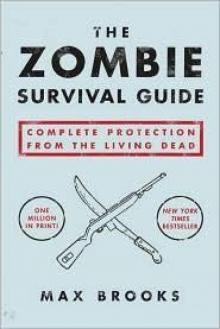 The Zombie Survival Guide: Complete Protection From the Living Dead
The Zombie Survival Guide: Complete Protection From the Living Dead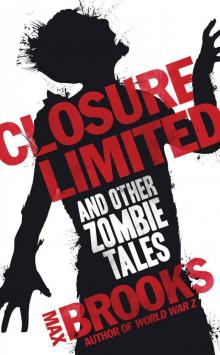 Closure, Limited and Other Zombie Stories
Closure, Limited and Other Zombie Stories Devolution: A Firsthand Account of the Rainier Sasquatch Massacre
Devolution: A Firsthand Account of the Rainier Sasquatch Massacre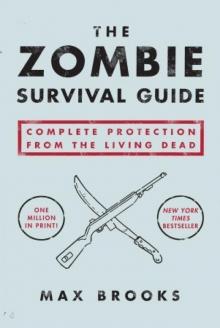 The Zombie Survival Guide
The Zombie Survival Guide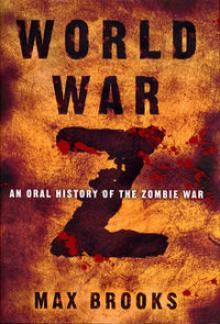 World War Z
World War Z Closure, Limited
Closure, Limited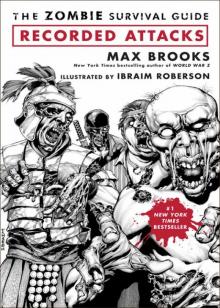 The Zombie Survival Guide: Recorded Attacks
The Zombie Survival Guide: Recorded Attacks World War Z_An Oral History of the Zombie War
World War Z_An Oral History of the Zombie War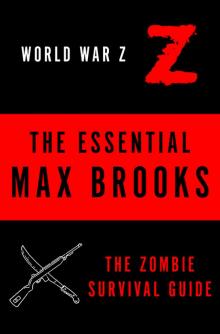 The Essential Max Brooks: The Zombie Survival Guide and World War Z
The Essential Max Brooks: The Zombie Survival Guide and World War Z